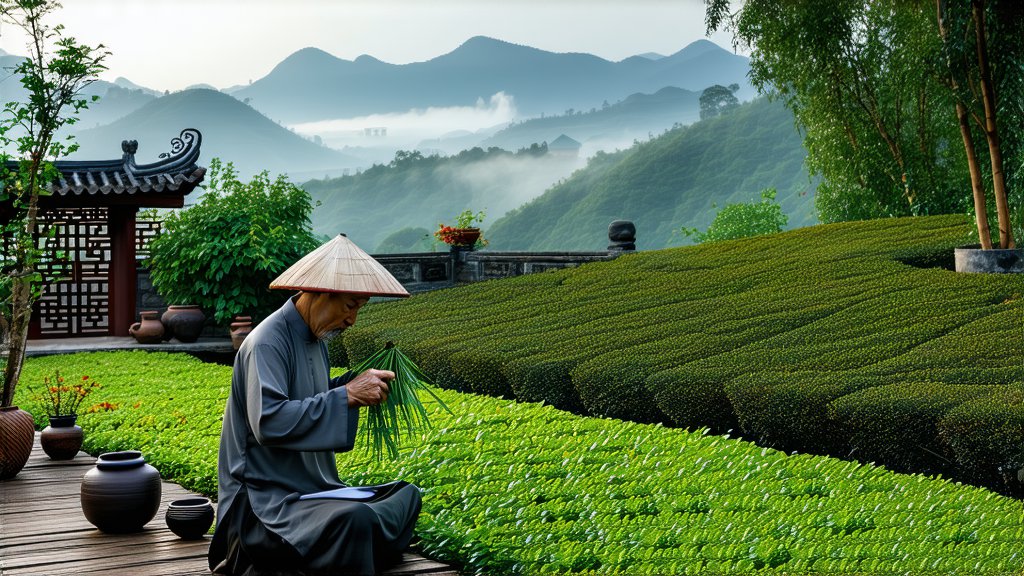
In the vast and diverse landscape of Chinese tea culture, few varieties captivate the senses and imagination quite like Tieguanyin, often referred to as the "Iron Goddess" of Oolong teas. This revered beverage, originating from the lush hills of Anxi County in Fujian Province, boasts a rich history intertwined with legend, a unique cultivation process, and an intricate art of brewing that has earned it global acclaim. Join us on a journey to unravel the mysteries and marvels of this extraordinary tea.
Historical Legacy
Tieguanyin's tale begins in the early Qing Dynasty (1644-1912), amidst the picturesque landscape of Anxi. Its name is said to derive from a local legend involving a poor scholar who discovered a divine tea bush while seeking shelter under a sacred Bodhi tree during a thunderstorm. Moved by the scholar's piety, the gods bestowed upon him the gift of this extraordinary plant, which he propagated for the benefit of mankind. Over centuries, Tieguanyin has evolved from a regional delicacy into a symbol of Chinese tea excellence, cherished by emperors and common folk alike.
A Symphony of Varieties
While Tieguanyin itself stands as a distinct variety, it encompasses several sub-varieties, each with its own unique characteristics. Among them, the most renowned include:
-
Xiang Pian (Fragrant Variety): Known for its high floral aroma and sweet taste, Xiang Pian is the most popular type of Tieguanyin, often sought after for its delicate fragrance reminiscent of orchids or magnolias.
-
Dan Cui (Single Bush): This rare and expensive variety is harvested from ancient tea trees, offering a complex flavor profile with hints of fruitiness and a long-lasting aftertaste.
-
Rui Xiang (Auspicious Fragrance): As the name suggests, Rui Xiang boasts a particularly strong and pleasant aroma, making it a favorite among connoisseurs who appreciate a more intense olfactory experience.
The Art of Crafting Tieguanyin
The magic of Tieguanyin lies not only in its genetic makeup but also in the meticulous craftsmanship involved in its production. The process can be broadly divided into four stages:
-
Withering: Freshly picked leaves are spread out under the sun or in shade to reduce moisture content, allowing enzymes to start breaking down complex compounds.
-
Brutonizing (Tossing or Shaking): Leaves are tossed in bamboo baskets or shaken mechanically to further bruise the edges, facilitating oxidation and releasing aromatic compounds.
-
Fixation (Pan-frying): The bruised leaves are quickly fried in woks to halt enzymatic activity, preserving the desired level of oxidation and locking in flavors.
-
Rolling and Drying: Finally, the leaves undergo multiple rounds of rolling to shape them into tight pellets and are then dried to achieve the optimal moisture level for storage and brewing.
The Gongfu Tea Ceremony: Savoring Tieguanyin
To truly appreciate Tieguanyin, one must engage in the traditional Gongfu tea ceremony, a ritualistic practice that elevates tea drinking into an art form. Here’s a simplified guide to experiencing this exquisite tea:
-
Preparation: Use a Yixing clay teapot or a Gaiwan (a lidded bowl) specifically designed for Oolong teas. Rinse the vessel with hot water to warm it up.
-
Infusion: Place about 5 grams of loose leaf tea into the pot. Use water heated to around 200°F (93°C). Steep for approximately 30 seconds for the first infusion, then gradually increase steeping time for subsequent infusions.
-
Appreciation: Observe the unfurling leaves, inhale the evolving aromas, and savor each sip slowly, allowing the tea's complexity to unfold on your palate—a dance between sweetness, floral notes, bitterness, and a lingering finish.
-
Multiple Infusions: Tieguanyin is known for its resilience; it can be infused multiple times, each brew revealing new dimensions of flavor and aroma.
Conclusion
Tieguanyin is more than just a tea; it embodies the harmony between nature, tradition, and human ingenuity. Its allure lies not only in its exquisite taste and aroma but also in the cultural heritage and artisanal skills passed down through generations. As you embark on your own exploration of this Iron Goddess, let each cup transport you to the misty mountains of Anxi, where every sip tells a story of devotion, resilience, and the timeless pursuit of perfection.